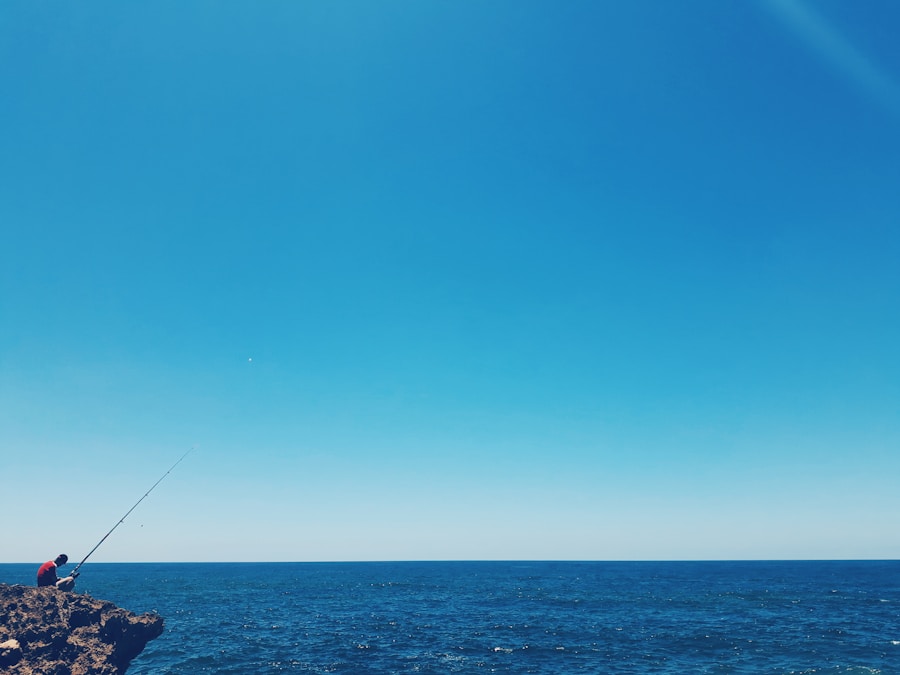Download links
How to install Mastering the Art of Ocean Fishing APK?
1. Tap the downloaded Mastering the Art of Ocean Fishing APK file.
2. Touch install.
3. Follow the steps on the screen.
Description
Selecting the appropriate fishing equipment is a fundamental step that can significantly influence the success of your fishing endeavors. The type of fishing you plan to engage in—be it freshwater or saltwater, fly fishing or deep-sea fishing—will dictate the gear you need. For instance, if you are targeting bass in a freshwater lake, a medium-action spinning rod paired with a spinning reel is often ideal.
This combination allows for versatility in casting and retrieving, making it easier to adapt to various conditions and techniques. On the other hand, if you are venturing into saltwater for larger species like tuna or marlin, a heavy-duty rod and reel setup designed to withstand the rigors of ocean fishing is essential. These rods are typically constructed from materials that resist corrosion and are equipped with stronger line capacities to handle the powerful runs of big game fish.
Beyond rods and reels, the choice of line and terminal tackle is equally crucial. Monofilament, fluorocarbon, and braided lines each have their unique properties that can affect your fishing experience. Monofilament is often favored for its stretch and ease of handling, while fluorocarbon is less visible underwater, making it a preferred choice for wary fish.
Braided line, known for its strength and sensitivity, is excellent for heavy cover situations where you need to pull fish out of dense vegetation. Additionally, selecting the right hooks, weights, and lures tailored to your target species can make a significant difference. For example, using a jig head with a soft plastic bait can be particularly effective for species like walleye or crappie, while topwater lures can entice strikes from aggressive species like pike or bass.
Key Takeaways
- Choose the right equipment: Select the appropriate rod, reel, and bait for the type of fish you want to catch.
- Understand the behavior of fish: Learn about the feeding habits, movement patterns, and preferred habitats of the fish you are targeting.
- Select the best fishing spots: Look for areas with abundant food sources, shelter, and suitable water conditions for the fish you want to catch.
- Master different fishing techniques: Practice casting, trolling, and jigging to adapt to different fishing environments and conditions.
- Practice patience and persistence: Be prepared to wait for the right moment and keep trying even if you don’t catch anything right away.
- Respect the ocean and its creatures: Follow fishing regulations, handle fish with care, and minimize your impact on the marine environment.
Understanding the Behavior of Fish
Environmental Factors
Fish are influenced by various environmental factors such as water temperature, light levels, and seasonal changes. For instance, many species exhibit specific feeding patterns that correlate with the time of day; dawn and dusk are often prime times for fishing as fish tend to be more active during these periods.
Seasonal Movements
Understanding the seasonal movements of fish can enhance your chances of success. In spring, many species move into shallower waters to spawn, making them more accessible to anglers. Conversely, during the heat of summer, fish may retreat to deeper waters where temperatures are cooler.
Weather Conditions and Feeding Activity
Moreover, the behavior of fish can also be affected by weather conditions. Overcast days can lead to increased activity as fish feel more secure in lower light conditions, while bright sunny days may push them into deeper waters or under cover. The presence of baitfish is another critical factor; where there are schools of baitfish, predators are likely to follow. Observing the water for signs of feeding activity—such as jumping fish or surface disturbances—can provide valuable clues about where to cast your line.
Selecting the Best Fishing Spots

Identifying prime fishing locations is an art that combines knowledge of fish behavior with an understanding of aquatic environments. Different species prefer different habitats; for example, trout are often found in cold, clear streams with plenty of oxygen and structure such as rocks and fallen trees. In contrast, catfish thrive in warmer waters with ample cover like submerged logs or vegetation.
Researching local bodies of water and their specific characteristics can help you pinpoint where certain species are likely to be found. In addition to natural features, man-made structures can also create excellent fishing opportunities.
Similarly, areas where rivers meet lakes or estuaries can be hotspots as they serve as migration routes for various species. Utilizing tools such as topographic maps or fishing apps can aid in locating these productive areas. Furthermore, engaging with local fishing communities or forums can provide insights into recent catches and popular spots that may not be widely known.
Mastering Different Fishing Techniques
| Fishing Technique | Success Rate (%) | Common Fish Caught |
|---|---|---|
| Fly Fishing | 70% | Trout, Salmon, Bass |
| Bottom Fishing | 60% | Grouper, Snapper, Flounder |
| Trolling | 80% | Mahi-mahi, Tuna, Wahoo |
| Casting | 75% | Pike, Muskie, Walleye |
The world of fishing encompasses a myriad of techniques, each suited for different environments and target species. Mastering these techniques can greatly enhance your effectiveness on the water.
These methods allow for precise presentations that minimize disturbance in the water, increasing the likelihood of enticing a strike from wary fish hiding among vegetation. Fly fishing represents another specialized technique that requires a unique set of skills and equipment. It involves using lightweight artificial flies that mimic insects or baitfish to attract fish.
Successful fly fishing demands an understanding of casting techniques such as the roll cast or double haul, as well as knowledge about matching the hatch—selecting flies that correspond to the natural food sources present in the water at any given time. Additionally, trolling is a technique often employed in saltwater fishing where lures are dragged behind a moving boat at varying speeds to entice predatory fish like marlin or mahi-mahi. Each technique has its nuances and requires practice to master effectively.
Experimenting with different methods can also lead to discovering what works best for you in various situations. Whether it’s learning how to read water currents for effective drift fishing or perfecting your retrieve speed for spinnerbaits, honing these skills will undoubtedly improve your overall fishing success.
Practicing Patience and Persistence
Fishing is often described as a test of patience and persistence; it is not uncommon for anglers to spend hours waiting for a bite. This aspect of fishing can be both challenging and rewarding. The ability to remain calm and focused while waiting for fish to take your bait is crucial.
Many seasoned anglers understand that some days will yield little success while others may result in a bountiful catch. Embracing this unpredictability is part of what makes fishing an enjoyable pursuit. Persistence plays an equally important role in fishing success.
If one technique or location does not yield results, it is essential to adapt and try something different rather than becoming discouraged. This might mean changing lures or baits, altering your retrieval speed, or even relocating to another spot entirely. The willingness to experiment and learn from each outing can lead to greater success over time.
Keeping a fishing journal can also be beneficial; documenting conditions, techniques used, and results can help identify patterns that may improve future trips.
Respecting the Ocean and its Creatures

Responsible Angling: A Multifaceted Approach
Respecting the Ocean and Its Inhabitants
It is crucial for anglers to foster a sense of respect for the ocean and its inhabitants. Sustainable fishing practices are essential not only for preserving fish populations but also for maintaining the health of aquatic ecosystems. This includes adhering to local regulations regarding size limits and bag limits, which are designed to ensure that fish populations remain viable for future generations.
Environmental Stewardship
Catch-and-release practices are also encouraged for certain species that may be overfished or vulnerable. Moreover, being mindful of the environment extends beyond just fish populations; it encompasses all aspects of marine life and habitats. Anglers should strive to minimize their impact on the environment by avoiding littering and being cautious about disturbing sensitive areas such as nesting sites or coral reefs.
Education and Responsible Stewardship
Educating oneself about local ecosystems can foster a deeper appreciation for the natural world and encourage responsible stewardship of aquatic resources. In conclusion, successful fishing requires a multifaceted approach that encompasses choosing the right equipment, understanding fish behavior, selecting optimal spots, mastering various techniques, practicing patience and persistence, and respecting the ocean’s delicate balance. Each element contributes to not only enhancing your skills as an angler but also ensuring that future generations can enjoy the same experiences on the water.
If you’re interested in ocean fishing, you may also enjoy reading about the mobile game “Jurassic World Alive 2” in which players can collect and battle dinosaurs in augmented reality. Check out the article here for more information on this exciting game.
FAQs
What is ocean fishing?
Ocean fishing, also known as deep sea fishing, is the practice of catching fish and other marine species in the open ocean. It typically involves fishing in waters that are deeper than 100 feet.
What types of fish can be caught through ocean fishing?
A wide variety of fish can be caught through ocean fishing, including tuna, marlin, swordfish, mahi-mahi, snapper, grouper, and many others. The specific types of fish that can be caught depend on the location and the time of year.
What equipment is typically used for ocean fishing?
Ocean fishing often requires specialized equipment, such as deep sea fishing rods and reels, heavy-duty fishing line, and large hooks and lures. Additionally, boats equipped with sonar and GPS technology are commonly used to locate fish in the open ocean.
What are some popular ocean fishing destinations?
Popular ocean fishing destinations include the Gulf of Mexico, the Caribbean Sea, the Pacific Ocean, and the Atlantic Ocean. Each of these locations offers unique opportunities to catch a wide variety of fish species.
Is ocean fishing sustainable?
Ocean fishing can be sustainable if managed properly. It is important for fishermen to adhere to catch limits, avoid overfishing, and minimize bycatch in order to ensure the long-term health of marine ecosystems. Many ocean fishing regulations and practices are in place to promote sustainability.





